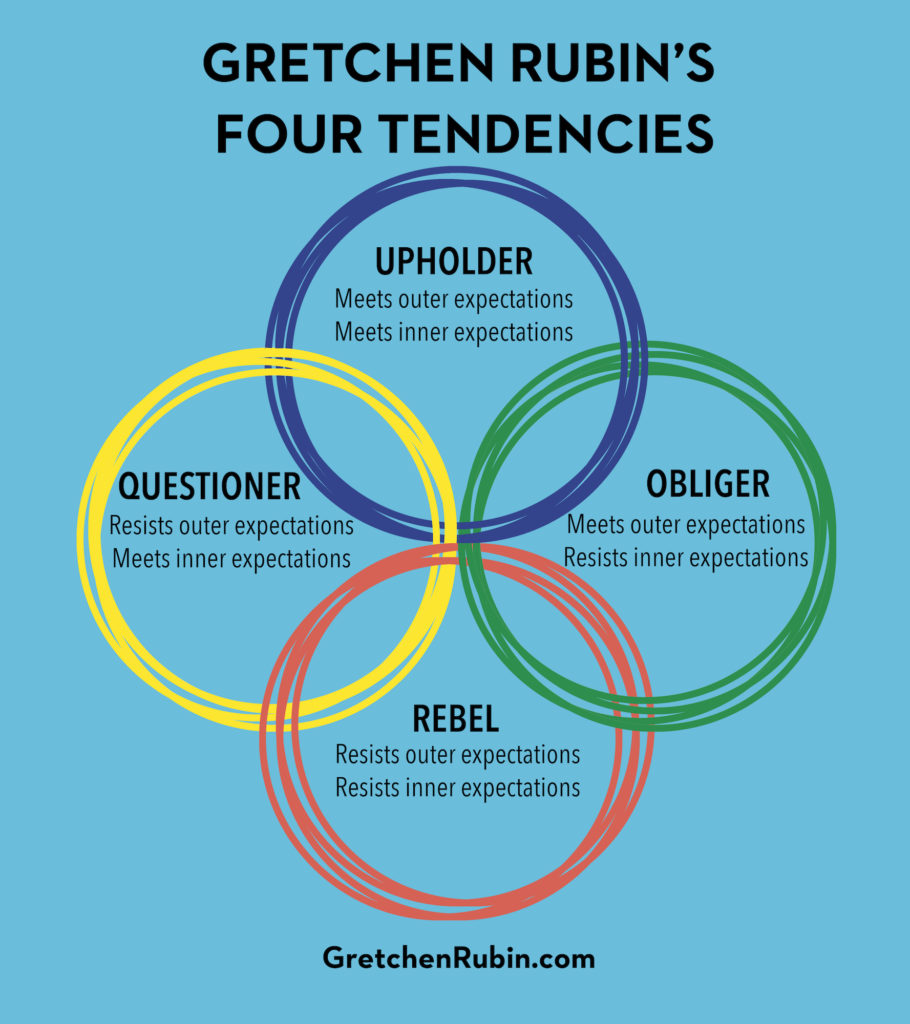1-Sentence-Summary: The Four Tendencies is a personality profile framework to help you understand how you and the people around you deal with their outer and inner expectations, so you can better manage your life, work and relationships.
Read in: 4 minutes
Favorite quote from the author:

Audio Summary
Listen to the audio of this summary with a free reading.fm account*:
When I first started coaching on coach.me, the CEO Tony Stubblebine sent all us early coaches a copy of a book that ended up influencing my coaching a lot. It’s also helped me understand my own behavior a lot better. The name of that book was Better Than Before. Gretchen Rubin, a former lawyer turned researcher, author and human behavior aficionado, wrote it in 2015 to much acclaim and success.
Somewhat hidden in that book, she introduced a framework of four personality types, which she called the four habit tendencies. It was the element of the book most people responded to, which caused her to dive deeper into the idea. Now, The Four Tendencies has become a full-blown concept in human behavior and is published as a standalone work of over 200 pages.
Here are 3 ideas from the book teaching you the core of the framework, why it’s especially important for one type and how you can use it to understand yourself and others:
- The names of the four tendencies are Upholders, Questioners, Obligers and Rebels.
- Most people are Obligers and it is the toughest group to be in.
- Do not pigeonhole yourself into your profile, just use it to learn more about yourself.
I’ve known I’m an Upholder for two years now, and it’s made all the difference. Ready to learn about your own tendency to improve your behavior and relationships? Let’s get right to it!
Lesson 1: The four tendencies are Upholders, Questioners, Obligers and Rebels.
When we’re babies, no one expects us to do anything. Our parents celebrate it when we eat, clap when we poop and let out a huge sigh of relief when we finally fall asleep. As we grow up, this changes fast. It starts with “clean your room,” soon turns to “you need to contribute to the household” and ends with “you have to take care of yourself now.” Most of us aren’t ready for all the expectations the world piles onto us, let alone the internal ones we have of ourselves that add to the pressure.
And yet, somehow we deal with them. We learn, we struggle and over time, hopefully we get better. Of course we develop much of our approach to dealing with our internal and life’s external expectations subconsciously. Identifying the approach you’ve shaped so far is what The Four Tendencies are for. Each tendency is linked to a specific strategy for dealing with the two kinds of expectations we face, which can be perfectly summed up in this graphic Gretchen made:

Here’s a little cheat sheet you can use to remember what’s distinctive for each type and how to deal with them better:
- Upholders meet inner and outer expectations. They love rules, having a clear plan and are self-motivated and disciplined. Clearly tell them what needs to be done and they’ll lead the way.
- Questioners meet their own expectations, but resist outer ones. They need to see purpose and reason in anything they do. Make it clear why what you want from them is important.
- Obligers meet other peoples’ expectations easily, but struggle with their own. The must be held accountable by a friend, coach or boss to get things done. They thrive when they have a sense of duty and can work in a team.
- Rebels defy both outer and inner expectations. Above all, they want to be free to choose and express their own individuality. Give them the facts, present the task as a challenge and let them decide without pressure.
Now that you know the basics, let’s look at the biggest and toughest group in more detail: Obligers.
Lesson 2: Obligers are the biggest and hardest group to be in.
Over 700,000 people have taken Gretchen’s quiz that reveals their tendency. The largest group are Obligers. This comes as no surprise when you consider that the entire education system of the Western world has been geared towards producing compliant workers for the past 100 years.
In theory, that’s not a problem, because it’s fairly easy for Obligers to make good use of their tendency. As long as they set up a good accountability system, they can be consistent and reach their goals. In reality, however, Obligers often face the biggest inner struggle, because they always put everyone else before themselves. Over 65% of them report feeling frustrated over their inability to prioritize what they want. This can culminate in self-sabotage through little acts of defiance that end up hurting themselves more than anyone else, for example failing a test on purpose, just to prove a point.
That’s why they also benefit from knowing their own tendency the most. Also, it’s important for us, the other types (I’m an Upholder, remember?), to tolerate them, be patient, and help them build the systems they need to thrive.
Lesson 3: Don’t box yourself in with this framework, use it to understand your own behavior better.
It’s easy to get carried away with personality types like these, but that’s dangerous. When you chisel your tendency in stone you might accept it, but you’ll also turn it into an excuse and stop believing that you can change. But that’s not the point of this exercise.
Gretchen says no type is more successful or happier than another. Sure, some careers are better suited for Obligers than Questioners, but remember, these are tendencies, not absolutes. What’s more, human behavior is fluid. We act on a spectrum and we can change even our most habitual routines in the long run.
Instead of putting yourself in a box, use this concept to get to know yourself better, identify your strengths and weaknesses, and improve your relationships with others by being mindful of their tendencies. If you’re dating a Questioner, go out of your way to explain your reasoning. When your boss is an Upholder, present him or her with structure. And so on. That’s where the true power of Gretchen’s work lies.
After all, she originally presented it in a book that was meant to make your life better, Better Than Before.
The Four Tendencies Review
I’m really glad Gretchen doubled down on this idea, as I too would agree it was one of the best aspects of her previous book. After I learned I’m an Upholder, I made a more conscious effort to not overload myself with rules and let go of habits when they become too rigid. I’m more calm, peaceful and relaxed as a result. A great foray into human behavior, big respect for Mrs. Rubin.
Who would I recommend The Four Tendencies summary to?
The 29 year old young professional, who’s already frustrated by her lack of time for herself from her first proper job, the 47 year old team leader, who must manage lots of expectations, and anyone who’s interested in human psychology and behavior.
Last Updated on August 11, 2022